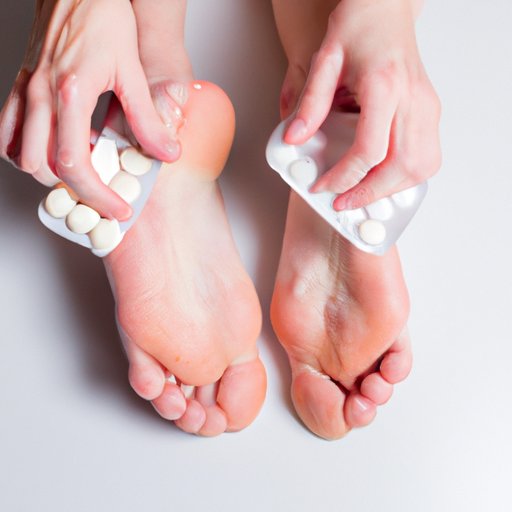
Introduction
Blisters are a common skin ailment that most of us experience at some point in our lives. They can be caused by friction, burns, or allergic reactions. While blisters can be painful and inconvenient, the question is, can you pop them? The answer to this question is not a straightforward one, but rather, it depends on the situation. In this article, we will explore the world of blisters by discussing the do’s and don’ts of popping blisters, when to avoid popping them altogether, different treatment options for blisters, prevention tips, and the potential risks and dangers associated with popping blisters.
“The Do’s and Don’ts of Popping Blisters: A Comprehensive Guide”
The circumstances under which it is safe to pop a blister are limited. If the blister is small and in a location that frequently experiences friction, such as the bottom of the foot or the palms, and if it is causing discomfort or pain, then it may be safe to pop the blister. However, if the blister is large, painful, or infected, or if it is located somewhere delicate or bulky, such as a blood blister in a finger, then popping the blister is not recommended.
If you decide to pop a blister, it’s important to do it properly. Sterilization of your skin and the tools you use to pop the blister are essential to prevent infections, which can be life-threatening in some cases. Wash your hands with soap and warm water, clean the blister with an antiseptic solution, and use a sterile needle to puncture the blister, making sure not to remove the skin. Finally, apply an antibiotic cream and cover with a sterile dressing to prevent infection.
On the other hand, if you decide not to pop a blister, the blister can provide a natural barrier that prevents infection, which can speed up the healing process. If the blister bursts on its own, be sure to thoroughly clean and sanitize the area to prevent infections. This is especially important if the blister is on your feet and you’re going to be walking around in moisture-heavy environments, as humid conditions can promote bacterial growth and increase your risk of infection.
“To Pop or Not to Pop? The Great Blister Debate”
The question of whether to pop a blister sparks a lot of debate among medical professionals, athletes, and people with personal experience facing blisters. The pros of popping blisters include pain relief, improved healing, and prevention of further discomfort caused by friction. However, the cons of popping blisters include the risk of infection, increased pain, and prolonged healing time due to scarring and thicker skin.
In general, if the blister is small and isn’t causing much discomfort, medical professionals recommend leaving the blister alone and letting it heal naturally. However, if the blister is large and painful, seeking medical attention from a doctor is suggested, as they may need to drain the fluid and provide proper care and treatment.
“Relief at Last: How to Treat a Blister at Home”
If you choose not to pop a blister, there are several options available to offer relief and promote healing. Topical ointments, such as antibiotic creams or petroleum jelly, can soothe the skin and keep it moisturized. Bandages can also help protect the blister from further friction. Over-the-counter pain relievers like ibuprofen or acetaminophen can reduce discomfort and inflammation.
Alternatively, if you’re experiencing discomfort, but you don’t want to pop the blister, you can also try soaking the blister in Epsom salt or applying a cold compress to alleviate any pain and swelling.
“Blister Prevention 101: Tips for Avoiding Painful Blisters”
Prevention is key when it comes to blisters. Several strategies can help keep blisters from occurring in the first place, such as wearing properly fitted shoes, breaking in your new shoes, wearing moisture-wicking socks, and using antiperspirant powder or spray to keep your feet dry. Furthermore, taking good care of your feet, such as washing them daily and keeping them moisturized, can also prevent blisters from popping up.
“The Risks and Dangers of Popping Blisters: What You Need to Know”
Popping a blister may seem like a quick fix, but it’s essential to understand the potential risks and dangers before you go ahead. One of these risks includes bacterial or viral infections, which can lead to serious health problems if left untreated. Other risks include prolonged healing time, scarring, and, in some cases, long-term skin damage. Additionally, if you suffer from certain health problems, such as diabetes or poor circulation, popping blisters can be especially dangerous and should be avoided at all costs.
Conclusion
Popping blisters can be tempting when you’re dealing with discomfort or pain, but it’s essential to weigh the pros against the cons and decide if it’s the right choice for you. If you choose to pop a blister, make sure to follow the proper technique and sterilization guidelines, or it can lead to further risk and danger. However, if you decide not to pop a blister, several methods can help alleviate your discomfort and speed up the healing process. In any case, prevention is key, so take the necessary steps to avoid blisters altogether. With proper care and attention, you can minimize the occurrence of blisters and keep your feet healthy and pain-free.




